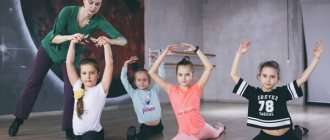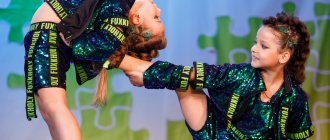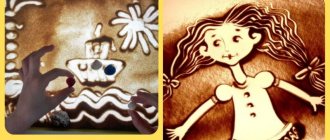Physical development of children through dancing
Children who regularly attend classes at a dance school enjoy good health. Properly selected physical activity and activity in the classroom contribute to:
- Strengthening all muscle groups;
- Formation of correct posture;
- Development of endurance;
- Improving the functioning of the heart and lungs, strengthening blood vessels;
- Development of coordination of movements, “muscle memory”;
- Development of flexibility and plasticity;
- Development of dexterity and speed of reaction.
Correct execution of dance movements requires school and considerable physical effort, but, unlike sports, dance lessons are practically harmless and have no contraindications.
Intellectual development of children
It may seem that active activities have little effect on children's intellectual development. But this is absolutely not true! Memorizing movements and their combinations perfectly trains the memory of preschoolers, and the need to constantly monitor the music, teacher and friends in the lesson perfectly develops attention. Lessons at the dance school develop spatial thinking, the baby quickly learns to perceive the concepts of “top”, “bottom”, “right”, “left”, “side”, “in the middle”, “above”, “under”, “in front”, “ for" and so on. To transform into the image necessary for the dance, the child actively uses his imagination. In general, intelligence is the ability to adapt to new conditions and learn quickly. During classes, children not only perform prepared dances, but also often improvise. By getting to know himself and the capabilities of his body, the baby creates a fundamental basis for new discoveries.
Summer is the time to experiment
Any event will become brighter, more exciting and more varied if the guys prepare a beautiful summer dance, with original costumes and stage design. After all, summer is a time of experimentation, and dance art is the best platform for the creative process. As a rule, summer dances are prepared in advance and the following is thought out:
- direction;
- style;
- movements;
- number of participants;
- musical accompaniment.
But there are exceptions, when dances at a summer camp are performed in improvisation mode, it can be an interesting competition or a disco show. This is quite an interesting and fun activity, as it does not require additional preparation, and children can move to the music in a way that is interesting and comfortable for them and there is absolutely no need to adapt to each other and dance in unison.
An important place is occupied by the mood of the dancers during the performance, namely, kind smiles on their faces and eyes shining with happiness. This will give you the opportunity to charge the auditorium with rhythm and positivity. In the process of performing a children's summer dance , it reveals to the audience all the beauties of this season of the year:
- bright sun;
- wonderful mood;
- fun swimming;
- walks in the forest;
- funny Games;
- camping;
- a lot of joy and laughter.
So, summer dance for children is a whole story about what summer is and how fun it can be spent with friends, family, counselors and campmates. And what a great opportunity to give people happiness and give them the opportunity to smile at life and the surrounding summer sun.
Artistic and aesthetic development in dance school
Dancing instills in preschoolers a love of art, a sense of beauty, and also opens up for them a new way of perceiving the world - through music and movement. A variety of forms of conveying feelings is formed in the dance school through immersion in various images. With the help of plastic arts and artistic movement, children learn to express their creative ideas, moods, and thoughts. Babies also develop an ear for music and a sense of rhythm. Dance lessons undoubtedly contribute to the artistic and aesthetic development of preschool children.
The unity of movements and music is a special way of perceiving the world, which opens up to the child during dance classes and remains with him for life.
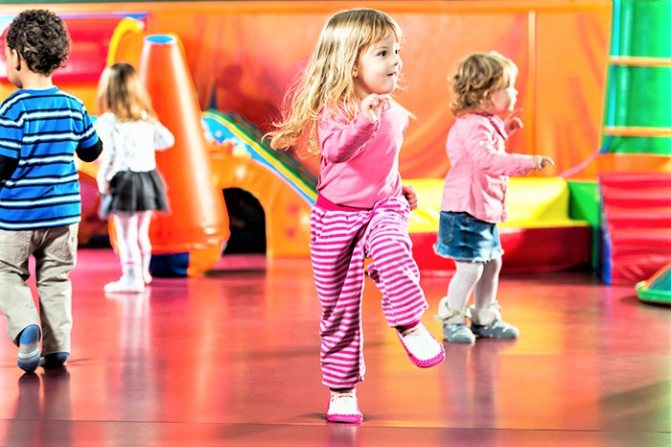
Consultation “Teaching dance to preschoolers”
One day a man came to a sage and said to him: “O Sage, teach me to distinguish truth from lies, beauty from ugliness. Teach me the joys of life." The Sage thought and... taught the Man to dance.
Dance is a synthetic art. It is aimed at solving the musical-rhythmic, physical, aesthetic and mental development of children. Movements to music accustom them to collective action and help foster a sense of collectivism, friendship, camaraderie, and mutual respect.
Currently, the attention of children and teachers is attracted by modern rhythms of music and new dances. But sometimes you have to deal with the fact that children, watching adults dance in everyday life, imitate the worst examples of their performance (they make faces, break, dance rudely, unmusically). This causes great concern, since it is in preschool age that the foundations of artistic and musical taste are laid.
It is easier for children to convey their understanding of music not through words, but through movements. And this is a good prerequisite for the creative process.
To teach a child to convey the character of a musical work, its figurative content through the plasticity of movements to music - this is exactly what the work on dance is aimed at.
By acquiring knowledge and skills in the field of dance art, children begin to understand that each dance has its own content, character, and image. To convey the expressiveness of dance images, the child must remember not only the movements themselves, but also their sequence (which in itself has a positive effect on the development of memory and attention), but also mobilize imagination, observation, and creative activity.
Types of dances
- dances and dances with fixed movements, the construction of which is determined by the structure of the musical work;
- free dances and dances , in which the creative abilities of the performers are most clearly manifested;
- combined dances , including fixed movements and free improvisation;
- folk dances and dances based on authentic elements of folk dance;
- character dances performed by various characters;
- children's ballroom dancing , including polka steps, gallop, waltz movements and others.
Creation of children's dances
The first way is to work on lightweight versions of existing dances for adults, accessible to children, using the same music. They preserve the dance movements for adults and its pattern, but reduce the number of figures, simplify the composition, and eliminate the most difficult elements for children to perform.
Another way is to create a new children's dance based on music that children like and that is suitable in terms of musical structure and form. Such dances include program dance skills required for preschoolers (springs, hops, galloping steps, side steps, rhythmic claps, etc.), many of which are performed in a new modern manner. At the same time, new elements are introduced.
Methodical techniques
Display method: involving display (joint execution of movements), advanced display, fragmentary display.
By showing children movements, the teacher gives them the opportunity to see the artistic embodiment of the image.
Verbal method. Spoken speech is the link between movements and music.
Verbal explanations should be brief, precise, figurative and specific. It is also necessary to pay attention to intonation and the force with which the word is spoken.
Words are symbols denoting movements: “sun”, “house”, “balls”, “tails”.
Gestures with spoken words that reveal the meaning of this gesture: “why are you sitting here”...
Illustrative visualization method. A full-fledged activity cannot take place without a story about dances, their history and diversity, without introducing reproductions, book illustrations, photographs and videos. Hall markings. Schemes-cards.
Game method. The essence of the play method is that the teacher selects toys for children that help in learning. Toys ( attributes ) decorate the dance and have a great influence on its performance. Captivated by the toy, children stop fixating their attention on the technical features of the dance. Transformation games will help teach children to perform expressive movements and develop their imagination and creativity.
Concentric method. This method consists in the fact that the teacher, as the children master certain movements and dance compositions, returns to what they have learned, but can now offer a more complicated version.
Showing children performing this or that movement well.
Stages of learning musical-rhythmic movements
Stage I – initial training in new musical movements; Stage II – in-depth learning; Stage III – consolidation and improvement of musical and rhythmic movements.
Training at the first stage is aimed at creating in children a general understanding of the new movement in connection with music. To interest children in dance, the teacher must give a general description of the dance and note its features. Listening to dance music, understanding its content and features, and analyzing its structure (individual parts, musical phrases) is of great importance. Children can be asked to clap accents, rhythmic patterns, the beginning of a new part, or a musical phrase.
The main actions of the teacher at the first stage of training:
- explanation;
- expressive performance;
- demonstration of a new dance movement by the teacher, corresponding to the content of the music.
At the second stage of training, as a result of the active work of the teacher and children (in small groups and individually), mastery of basic movements in conjunction with music occurs.
The teacher analyzes in advance what mistakes children may encounter when mastering a particular movement, finds the exact words to explain individual details, thinks through figurative comparisons, clear brief instructions, and uses preparatory dance exercises.
Children can stand scattered or in a general circle, in this case they can clearly see the teacher’s demonstration (no one stands with their back or side to him), and the teacher, in turn, has the opportunity to control the quality of movements. If children stand scattered, the teacher’s display should be mirrored.
The teacher must constantly monitor the children’s movements in accordance with the tempo, rhythm, dynamic shades of music, correct mistakes, and encourage them.
The main features of a developed musical motor skill are the conscious execution of movements in accordance with the nature of the music and the quality of execution (accuracy, rhythm, expressiveness).
At the third stage , the task is to bring the skills acquired by children in musical and rhythmic movement to the degree of independent creative performance and use of dances and games in everyday life. Children approach independent creativity gradually, through feasible or creative tasks, which are offered in sequence from simple to more complex.
Stages of learning exercises:
1. Verbal explanation by the teacher, then demonstration of the exercise by the teacher accompanied by musical accompaniment. 2. Learning complex movements (“variable step”, “polka step”...) according to
in parts, first to the count, then to the music. 3. Show a child who has mastered this exercise. 4. Reinforcement of the exercise by all children in subsequent classes. 5. Assessing the children’s performance of the exercise.
Dance - improvisation
Dance improvisation is a way to develop creative abilities and nurture creativity in preschoolers. Children are characterized by a rich imagination and imagination. Therefore, games, free improvisations, plastic performances arouse their interest and enthusiasm, and are performed easily and naturally. Such exercises should be performed by children in classes throughout the year.
“Choreography implies “ownership” of the body; the body in this case is the object towards which the action is directed.
Improvisation involves co-creation with the body, recognition of the equal importance of pre-formed plans and experiences, and momentary impulses. For improvisation, you need a feeling and “thinking” body, something that was present in ancient cultures based on the idea of “unity with nature” - Grishon A.E.
Feelings of body freedom contribute to the development of the ability to improvise.
In classes with preschoolers, several areas for developing the ability to improvise can be distinguished:
1. Feeling of the “body”.
2. Communication with a partner - partnering.
3. Understanding movement in creativity: drawing, crafts….
4. A set of movements to create a basic basis for improvisation.
, musical sketches provide invaluable assistance for example from E. Gorshkova’s methodology “From Gesture to Dance” (“Met”, “In the Forest”, “Let’s Be Friends”, “Secret”). And also studies on the expression of emotions, on the reproduction of individual character traits, on the training of individual muscle groups by M. Chistyakova from her book “Psychogymnastics”. For example, such as “Barbell”, “Icicle”, “Everyone is Sleeping”, “Different Moods”, “Sentry”, “Fear”, etc. In them, children learn with interest to communicate with each other using the language of movements, to convey in plastic various emotional states that are close to them from their own life experience.
It is useful to use communicative, character and plot improvisations with poetic or prose accompaniment.
Communicative dance is a dance with simple, light, playful components, and evokes a lot of positive emotions in children (Briske’s Dance “For me, for you,” Zheleznov’s disc: “Dwarfs and Giants.”)
Characteristic dances: of a character (Zheleznov’s “Three Little Bears”).
Logorhythmic exercises: “Cat’s house”, “The cat inflated the ball”.
Then, when children get used to this kind of tasks, improvise freely and naturally, show creative independence and activity, you can introduce free improvisations with objects (Briske dance with hoops “To the village to visit grandma”: sun, hat, skirt, house.)
The main requirement for dance improvisation is that each improvisation is performed only once, since if the composition is repeated, it loses the character of creativity and improvisation.
Game "Body Parts". We study body parts. After getting to know each other, you are given the task to move (dance) a certain part of the body. The movements are based on improvisation. At the next stage of the game, the tasks become more complicated: speed and movement dynamics are added.
Exercise "Mirror". Children look in the mirror, “make faces”, developing facial muscles, then the task becomes more complicated, the child must convey these facial sensations without looking in the mirror. In this way, internal sensations develop. An option to complicate the game: children become pairs: one depicts a mirror, the second a reflection. The task is to make the mirror and reflection unrecognizable.
It is important to create a comfortable atmosphere in the team, teach children to communicate with each other, and trust each other.
Game "Partnership". Children become pairs (the teacher first observes who is in contact with whom), one in the pair closes his eyes, completely trusting his partner, who sends impulses to the partner’s back with his palm, directing his movement. The task of the second is to guide the partner without clashes, the first is to completely trust the partner.
"Imagine who you are" technique . Children close their eyes. The teacher gives the task to imagine yourself as a bird. A story about what kind of bird it is helps the child imagine it in his imagination. The performances then need to be shown in motion. Observation of natural phenomena stimulates imagination and moves towards improvisation. It is necessary to give the task more often: observe a phenomenon, animal, object, and then talk about it in class.
Game "Word Action". The teacher names the quality of movement. For example: a tree is swinging (swaying), a sweet toffee (stretching), we are rolling a roll (twisting), we are late (walking, running). To complicate the exercise, you can independently compose stories based on your experience. Mastering the technique broadens the child’s horizons.
The game "Silent" requires a little experience in movements. Goal: carefully monitor the changing movements of the teacher, who is silent and makes them as he moves around the hall, and repeat the movements. The result can be very unexpected: children, carried away, actively enter into the process and begin to independently compose movements, as if not noticing everyone around them; this is an excellent result in the development of the ability to improvise in preschoolers.
Not all children succeed in completing tasks, because we are talking about creativity, which requires choreographic talent and talent. Children who did not get the expected result have their own reasons: personal, psychological, etc. And yet, for them, the techniques used are also useful in terms of art therapy.
“Of all the feelings, joy has the best influence on the development of a child’s abilities; he most willingly surrenders to this feeling and his soul is open to educational influence” Emile Jacques-Dalcroze.
Literature:
1. Grishon A.E. Improvisation and choreography [Electronic resource] - Access mode. — URL: https://www.girshon.ru/index.php/moi-stati/articles/improvizacija-i-xoreografija.html (access date 08/12/2013).
2. Literature and language: modern illustrated encyclopedia [Text] / Ed. A.P. Gorkina. M.: Rosman, 2006. - 584 p.
3. Samukina N.V. Games at school and at home: psychotechnical exercises and correctional programs [Text] / N.V. Samoukina. M., 1993. - 144 p.
4. Churilova E.G. Methods and organization of theatrical activities for preschoolers and primary schoolchildren [Text]: Program and repertoire / E.G. Churilova. M., 2001. - 160 p.
Development of personal qualities
Listening to music makes a great contribution to the development of a child’s personality, including his emotional sphere, because it contains many experiences, emotions, feelings, and events. Thanks to dancing, children recognize themselves and become well oriented in their inner world. In addition, children develop such qualities as:
- Artistry;
- Creativity;
- Public speaking skills;
- Activity;
- Self confidence;
- Self-control;
- Discipline;
- Determination;
- Persistence.
We can say that this is a whole school of life.
Development of communication skills
Dance lessons help children improve their communication skills. Kids usually make new acquaintances without difficulty, because the atmosphere that prevails at the dance school is conducive to close emotional communication. Even shy and unsociable children are liberated and quickly join the team. Basically, dancing is teamwork, so preschoolers develop a sense of trust in others, and also develop skills of interaction with other people, the ability to find a common language with peers in the class. In choreography lessons, children are taught to express their emotions through facial expressions and gestures, and this greatly helps them better understand how other people feel.
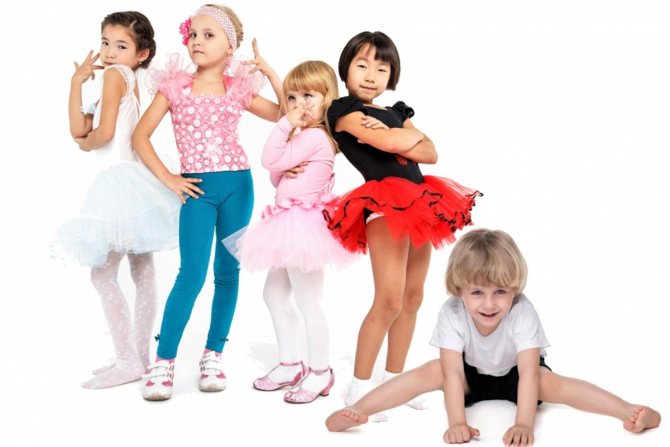
At what age can you start taking dance lessons?
Every parent wants their baby to actively and fully develop, so almost from the very birth of the baby they think about which club to send their child to, which will best prepare them for school. Most sections recruit children over 4 years old. But dancing is exactly the kind of activity that is suitable for children from 2-3 years old. This is due to the level of physical development of children of this age and their needs. At 2 years old, children usually love everything that has to do with movement. They can run, jump, and overcome obstacles almost without stopping. As the vestibular apparatus develops, the ability to maintain balance develops. By the age of 3, movements become more precise and coordinated, and reaction speed increases. From 4-5 years old, preschoolers have access to complex motor skills that require good physical fitness, dexterity, flexibility and speed of reaction. Of course, preschool children, in most cases, cannot master complex choreography and achieve high results. But dancing classes under the guidance of a professional and attentive teacher will allow the child to express himself and fully satisfy his need to be in motion, as well as prepare the basis for future victories. To accurately determine whether your baby is ready for dance classes, you can ask yourself the following questions:
- How does your child prefer to spend his free time? Does he like active or quiet games?
- How does the baby tolerate physical activity?
- Will he be able to listen to the school teacher and fulfill his requirements?
- And most importantly: does the child like to dance? To find out, you can simply watch the baby or invite him to dance with you.
Children aged 2-4 years, along with older preschoolers, can safely be sent to dance lessons, since active physical development occurs at this stage, but the individual characteristics of the child must always be taken into account.
Dancing for children: TOP 10 dance studios in Moscow
Academy of Arts "Muse"

st. Myasnitskaya, 13, building 20
Over the three years of the Academy’s existence, the best trends in dance and music have been collected here, which will allow your child to realize himself and achieve great heights in his chosen field of creativity.
The studio's profile is classical ballet. The school is taught by Bolshoi Theater soloists with many years of teaching experience. For children from 2.7 years old, the author’s program “Introduction to Ballet” has been created, which will help the child acquire all the necessary basic skills and discover talent.
The Academy of Sports and Ballroom Dances combines sports and art. Breakdance and hip-hop teams are perfect for boys who want to become strong and strong in spirit. There is a vocal academy for all children, where everyone can take lessons from a graduate of the Gnessin Academy of Music and improve their sense of rhythm.
Moscow School of Irish Dance Maria Singal
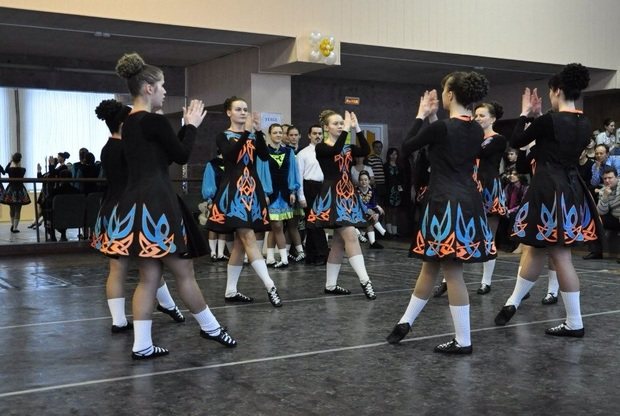
Preobrazhenskaya sq., 12
Jig, reel or hornpipe? At Maria Singal's school you can learn all the main types of solo and pair Irish dances! And not only to learn the basics, but also to become a professional: students of the institution often participate in international competitions. Now the school's arsenal includes first place in group Irish dancing at the European Championships, second places in solo programs at world competitions and other awards. Perhaps it's all about the quality of teaching. The founder of the school, Maria Singal, is the first certified teacher of Irish dancing in the Russian Federation (TCRG) and a judge of international championships (ADCRG), all teachers undergo advanced training courses abroad. In addition, the lessons do not just study the elements and patterns of dance. The studio provides stretching classes, a special “show class” for stage performances, and exercises to develop a sense of rhythm.
It’s worth bringing your child to Maria Singal’s school and... staying on your own: the groups accept adults without any age limit.
Gulliver

st. 1st Tverskaya - Yamskaya, 8
Classical choreography, hip-hop, folk, pop or club dancing - at the Gulliver school there are directions for every taste and age. This is not just about improving posture or showing basic movements. In “Gulliver” they give the opportunity to express themselves through music and dance, charge them with energy, teach them not to be afraid of the stage and prepare them for a brilliant future. Students of the school participate in popular TV shows, demonstrate items from the YanaStasia brand, appear in video clips and easily enter theater universities in the capital.
Training for schoolchildren takes place 3 times a week for 2 hours and costs 5,500 rubles per month. Children under 7 years old study twice a week for 1 hour. The cost of training is 4000 rubles per month.
House of dance in the cultural center "ZIL"
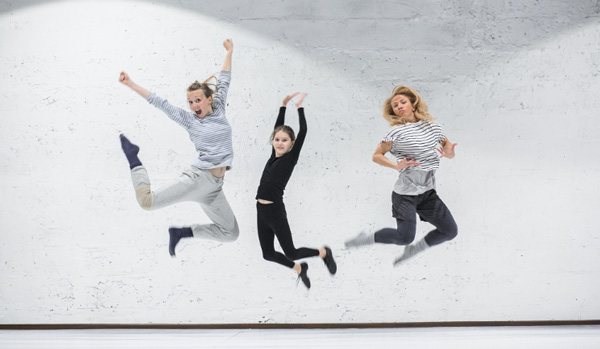
st. Vostochnaya, 4, building 1
The House of Dance is culturally called the epicenter of dance creativity. You can find inexpensive programs here for children of any age and skill level.
In ZIL you are invited to enroll in ZumbaKids classes - for exciting children's parties for children from 3 years old. Does your soul lie in the classical direction? The children's ballet theater in the Palace of Culture has existed since 1982; classes for children over 4 years old include rhythmics, gymnastics, classical and modern dances and even stage practice. And “Young Zilovets” is the oldest folk dance ensemble; teenagers will be interested in visiting the hip-hop, street dance, and popping studio. There are also areas of ballroom and pop-sports dance. Most recently, the Dance Theater opened in ZIL, an association for children 3-12 years old, designed to teach students modern dance. There are budget places.
Eco-club “Umnichka”
Mozhaiskoe highway, 45, building 1
Moscow dance studio Eco-club “Umnichka” is a cozy and, importantly, safe space for children of different ages. Safe in the truest sense of the word, environmentally friendly and hypoallergenic materials were used to decorate the premises.
You can sign up for dancing at the development center from 2.5 years old; for the little ones, the optimal direction will be “Dance Rhythm”. For older children - pop dancing (from 3.5 years old), choreography in the ballet hall - from 4 years old. Well, schoolchildren will certainly like the modern trend - hip-hop, house and club children's dances. All courses are aimed at small groups of up to 8 dancers; at Umnichka they are taught by “star teachers”. On average, the duration of one lesson is 45-50 minutes.
Yegor Simachev Ballet Workshop
st. Karetny Ryad, 3, building 7
You can experience beauty through classical ballet within the walls of Yegor Simachev’s workshop. Here they instill a love of dancing in children aged two years and older. The best of the most famous choreographic studios in Moscow has many branches, so it will not be difficult to sign up for classes as close to home as possible.
Ballerinas of the Bolshoi Theater and professional choreographers teach beauty and lightness, magical flight in dance. Children can put on a tutu and special shoes for the first time during a trial lesson to feel in their hearts whether ballet is right for them. And even if the child does not want to go on stage in the future, in the studio he will learn to think creatively, work on himself, and acquire graceful posture. Lessons for little dancers are built in a special rhythm, alternating with play exercises, so everyone will be comfortable.
A subscription for four classes costs 4,000 rubles, a one-time visit costs 1,250 rubles. You can study either in a group with peers or individually. Duration – from one hour.
International Center for Dance and Performance "TSEKH"
st. Skakovaya, 24
Parents and their children can find out what contemporary dance is by enrolling in the dance school of the Tsekh association. This international center is able to convince that modern dance is a special genre.
However, the program covers not only the study of steps; students learn the basics of creative movement and participate in non-verbal theater. All teachers of the “Workshop” are young and energetic people who are in love with their work. For children there is a division by age: 3-5, 6-9, 10-12 years. Recruitment for the group is carried out every season.
TODES
Paveletskaya embankment, 2, BC “River side”
Enrollment in the dance school under the direction of Alla Dukhova starts from the age of 4. Show ballet “Todes” is a world-famous brand that offers group training for children. Moscow has many branches, and there are no less of them in the regions, so you will definitely be able to enroll in a school closer to home.
You do not need to have a certain level of physical fitness to attend rehearsals. You can start getting acquainted with classical ballet, hip-hop, jazz-modern and other dance styles from scratch. Each training session - individual lessons are not provided - is built according to a certain scheme: warm-up, learning new elements, staging a dance routine and consolidating what has been learned. Children in the Todes show ballet will be able to participate in competitions, studio reporting concerts, outdoor events and more. Lesson duration – 1 hour 15 minutes.
GALLADANCE
Krasnopresnenskaya embankment, 12
A boost of vivacity, self-confidence and impeccable posture, coupled with a good mood, can be found by choosing your favorite training program at the Galla Dance dance school.
Enrollment in children's groups starts from 4 years old; the Zumbatomic direction is open for the youngest. From the age of 6 you can sign up for oriental or ballroom dancing, including fiery Latin American dances. From 13 years old - welcome to ClubDanceTeen. What’s noteworthy is that parents of their child can get detailed advice from the school’s choreographers to decide which dance style is best for their child. The trial lesson is free, individual or group training is possible (from 7 to 20 people in a team)
ABOVE THE MOUNTAINS
st. Malaya Ordynka, 25
Children can also learn to dance the sparkling lezginka, charging those around them with positivity. Complex, but bewitching art, demonstrates lightness, grace, refined movements and virtuoso music - how can you not like Caucasian dances?
The school “Above the Mountains” offers training in Caucasian and Transcaucasian dances for children over 3 years old. Groups are recruited year-round; you just need to have a tremendous desire to dance. The cost of one lesson for children is 350 rubles, a subscription for 8 lessons is 2800 rubles, there are individual lessons.
conclusions
When parents are faced with a choice of which section or club to send their child to, many choose a dance school. And this is exactly what children of early and preschool age need. Dance classes make a great contribution to the physical, intellectual, personal, social and aesthetic development of the child. Children involved in dancing develop self-control skills, the ability to work in a team and collaborate with peers, and listen to the teacher. When going to school, the child will be psychologically prepared for new conditions.
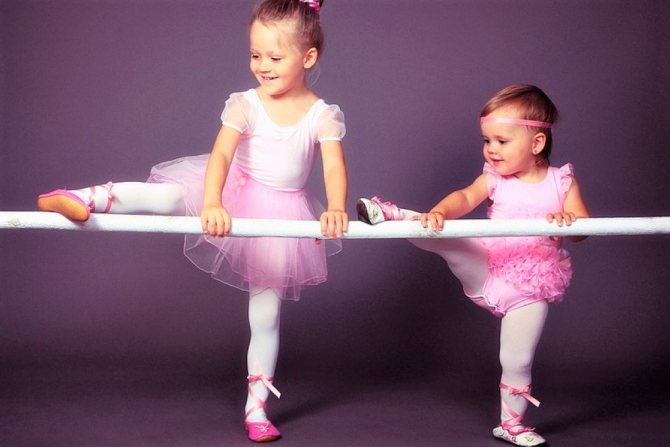
How to choreograph a dance in kindergarten. article on the topic
How to choreograph a dance in kindergarten.
This article is more likely intended for music directors than for parents, and it is dedicated to dancing, or rather to staging dance in a kindergarten, or in an early childhood group. Therefore, for those who have no interest in dancing, you don’t need to read this article, but for those who dare to understand such a beautiful art form with their children, I will describe the principle of staging a dance, the main stages of working on it, and of course the advantages of this type of activity.
When I just started working as a music director, I had a pretty good command of the skills of vocal and choral work, the listening section, and I could even do a pretty good warm-up (gymnastics) to music. But as soon as it came to dancing, the children’s attention immediately disappeared, they all scattered in different directions and stopped doing anything altogether. Of course, I was worried and nervous, but the question of why the music block goes so smoothly and the children do everything as if by a wave of a magic wand, but in the motor block there is complete stupor, forced me to actively study this type of activity and look for the most successful techniques.
The first thing I would like to note when talking about dancing is its benefits, both at a younger age, at an older age, and even at a very old (adult) age. The fact is that when we dance we move, which in itself is good. But we move for a reason, but to the music, which means we coordinate our movements with the rhythm of the music, thereby developing gross motor skills, coordination, muscle memory, a sense of rhythm, and spatial orientation. Physiologists have long proven that movement closely interacts with memory, speech, learning, emotions and stimulates the brain.
1 When it comes to dance in kindergarten, the first question that arises is what to dance; if you do not yet have sufficient experience in choreographing, then the best option would be to take a description of the dance from an experienced teacher and work from it. Still, the well-known law works well here: “Copy the master until you learn.”
2 Dancing with good, fast and energetic music looks most advantageous for children. Children perceive cheerful music more easily and move more actively to it, and at holidays (dances are prepared mainly for matinees), a lively and spectacular number will be perceived as a bright spot. And if the music is well recognized, then the audience will automatically have a slight emotion of joy. I’m not saying that there shouldn’t be smooth and slow dances; on the contrary, you should learn to dance to smooth music, but this is mainly for older preschool children and it’s better to choose well-known music.
How to choreograph a dance in kindergarten
3. Before learning the dance, I highly recommend letting the children move to this music themselves. Firstly, it develops creativity, and secondly, you can spy on the children at this moment a few successful movements and insert them into your act.
4. Conventionally, the dance can be divided into 3 parts: movements, pattern, ligaments. And the first thing that is worked on with children is movements, but don’t immediately dig too hard at this stage. Your task is to introduce children to the movements in order to learn the dance completely.
5. After getting acquainted with the basic dance movements, we move on to learning the pattern. I’ll tell you right away about the markup. You can mark the floor with dots, snowflakes, leaves, whatever. There are two opposing opinions, but I am strongly FOR markup, and I will explain why. Children (what can I say, and sometimes adults too) are rather poorly oriented in space. Not only do they need to remember when to go in which direction, where to stand, where to turn around, but in addition to this they also need to perform some movements. Therefore, I do not immediately torment them with the distance to the neighbor, but clearly show the point to which they need to gallop, run, walk on tiptoes, etc. Later, when the pattern is learned, they will dance guided by internal sensations of distance. This is the only thing they need to learn, and the markings here, of course, help both the children and the teacher. In my practice, there were experiments with 4-year-old children, whom my parents and I took to a competition and they danced on a completely different stage without any guidelines, although I taught them the markings.
6. We add movements and connections to the dance drawing, and run this draft many times until you see that the children know what’s what. And then you do the same thing and work on separate pieces in parallel, at the end of each lesson you run through the dance completely.
7. And one more important point in my opinion. Each movement must have its own name in words and hands. The name with words will help you prompt at the initial stage of learning, and the name with your hands will help you suggest at subsequent stages, and even at the holiday. There are times when the children were sick, did not go, and the dance was essentially raw, but a matinee had to be held, and in order not to get up to dance with the children, it was better to use a hint with your hands (just not sweepingly, but carefully, so that only the children would notice it).
These are the main points that you should pay attention to if you are going to learn a dance in kindergarten, but it is also necessary to remember that despite the seeming simplicity of the movements, they are difficult for children, since their brain is still developing and is just beginning to accumulate information .
If you have your own opinion on this matter, or liked the article, be sure to leave your comment below
